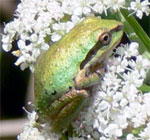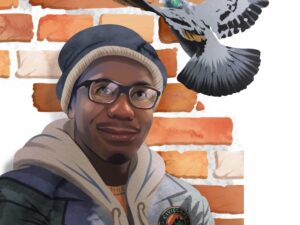If you happen to be in El Cerrito and hear a frog calling, or catch sight of a large yellow butterfly flitting through your yard, it might be Jim McKissock’s doing. Jim, founder of Earthcare, has been raising local native plants, Pacific chorus frogs, and butterflies on his property and around the Bay Area for over 25 years.
On a sunny window sill in Jim’s dining room sit a pair of wire cages, one with Anise Swallowtail caterpillars and eggs, the other sheltering eight chrysalises. In the lush backyard behind his cheerful Craftsman bungalow, an encyclopedia’s worth of endemic native plants – many of them now locally rare or extinct – fringe a frog pond. An electrified dog fence protects the pond’s inhabitants against raccoons and cats.
BN: Tell us about these chorus frogs.

BN: And where are those caterpillars from?
JM: I collect them from nonnative fennel plants and from native larval yampah plants at Canyon Trail Park, because otherwise they become victims of numerous predators long before they reach the chrysalis stage. Later, after they morph into butterflies I’ll release them back where I found the eggs or caterpillars.
BN: It looks like you have quite a few backyard restoration projects going on. Tell us about the one in your front yard.
JM: In the parking strip in front of my house I’ve planted small square plots containing salvaged native grasses and wildflowers from an area in Point Richmond that is now completely covered by the Seacliff Estates development. That area contained one of the very few scraps of untouched grasslands in the East Bay. My volunteers and I made twenty grids there before the area was built over, to study the spatial relationships between the several species of bunch grasses. This allowed us to replicate their natural growth patterns using plugs of these species in other restoration projects, like the one we’re doing at Canyon Trail Park.
BN: Are you an East Bay native?
JM: Yes, I was born in Oakland in 1943 and grew up in Richmond near the edge of the San Francisco Bay, exploring the natural world within my reach. Growing up in a tough neighborhood, I could have easily gone down the wrong path. But at several critical moments, when I could have turned to violence, I’d visualize myself casting a fishing line into the Bay or enjoying a peaceful moment out of doors.
-
Jim McKissock
BN: Tell us more about Earthcare.
JM: My organization is dedicated to the conservation, management and enhancement of our local natural resources. It operates with little or no funding. Funds and equipment are usually provided by myself and my dedicated volunteers. Earthcare undertakes habitat management, restoration, and stewardship of what’s left of our natural flora and fauna. I personally have over 25 years of conservation experience in all aspects of wild land management and stewardship.
BN: What are some current projects you’re working on?
JM: Earthcare is working in El Cerrito at Canyon Trail Park, in Brisbane at the Crocker Trail Wetland project, on the San Francisco chorus frog rescue project , and on several private conservation projects in Oakland and Berkeley.
BN: What do you love about your work?
JM: It has tremendous healing power. People both young and old, from all kinds of backgrounds find themselves healing as they help nature recover and heal. Engaging in an activity as simple as planting a seed from an endangered plant and watching it grow into a flower can fill anyone’s life with meaning. It can make a huge difference.
If you would like to learn more about Earthcare, contact Jim McKissock at earthcarenow@sbcglobal.net or at (510) 526-1233.

.jpg)




